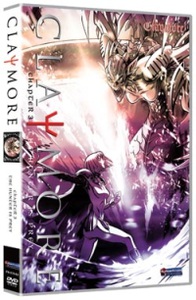Review
by Carl Kimlinger,Claymore
DVD 3
| Synopsis: |  |
||
The aftermath of Clare's first battle with an Awakened Being reveals to her, and her three comrades-in-arms, some shocking truths about the organization she works for. Bonded by their shared experience and precarious circumstances, they return, disillusioned and wary, to their duties. Though warned to avoid contact with the top five Claymores, who might detect her partially Awakened powers, Clare immediately finds herself paired with Number Four, Ophelia. A giggling psychopath of frightening power, Ophelia's idea of fun involves lopping allies' legs off and using innocent lives as bartering chips. When she discovers that Clare has Awakened, she gets really nasty. Wounded, separated from Raki and fighting a battle she knows she cannot win, Clare is forced to turn to her past for help. |
|||
| Review: | |||
The events of volume two continue to echo through Claymore's third installment. And how could they not? The second volume was powered by one of the nastiest twists in recent memory, demonstrating previously untapped reserves of narrative ruthlessness. Though this volume begins to weave a slew of more typically shonen-styled elements into the plot, that ruthlessness lingers, and with it a brutal edge that keeps Claymore perched firmly atop of the action anime heap. A training episode, ranked enemies to battle, and even a newly formed alliance of like-minded comrades—it's impossible to miss the encroaching shonen tropes. Clare's progress as a warrior is beginning to resemble the miracle rookie trajectory beloved by Shonen Jump fans the world over, and her back-story—for all its shock value—is a familiar one. But they are tropes wrapped in action so brutally extreme that the battles can't help but be tense. The slowly emerging complexities of the Claymore organization add a political dimension to the action, and the outcomes prove again and again to be mercilessly unpredictable. The disparate elements—particularly the monster-slaying—may be familiar, but they're imbued with a cold intensity that makes them undeniably engrossing. Comparisons to masterpieces of medieval fantasy like Berserk are, however, still premature. Claymore, with its graded superpowers and well-worn narrative progression, is at heart too conventional to compete with the genre's true luminaries. The epic scope and character nuance are lacking, and while more than competent, director Hiroyuki Tanaka hasn't the cutting insight that allowed Naohito Takahashi to tease devastating truths from his cast. But what Tanaka lacks in raw skill, and the script lacks in inspiration, the series makes up for in sheer faith in its visuals. Faith which is not misplaced. Filmmaking is, after all, a primarily visual art form. Gorgeous art can take a series far, and Claymore's art is exceptionally beautiful. Lush backgrounds rendered in washed-out grays and greens weave an atmosphere of medieval alienation from stunning, empty natural vistas and equally empty architecture. Clare's even, determined stride can distill her entire character into one economical movement, just as the stark contrast between the clean masonry of the holy city in volume one and the worn mundanity of the mountain villages can communicate without a word the social divides that the script hasn't the time to describe. The eerie beauty of Takahiro Umehara's whipcord Claymore designs hides their monstrous potential for violence behind masks of porcelain calm, while Madhouse's typically active animation gives visceral life to the manifestations of that violence in bloody, plentiful and sometimes balletic action sequences. Such a treat for the eyes is it that it's easy to overlook the contributions of the score and cast. The score—a solid but nearly invisible affair by professional understater Masanori Takumi—is careful to consign itself to a supporting role, so it's tempting to view the voice work in the same light. Until one watches the English version that is. Though effective in a meat and potatoes kind of way, Funimation's English adaptation is more a lesson in the subtle difficulties faced by the veteran Japanese cast than a separate-but-equal alternative to their work. Working from a script that discards rigorous faithfulness in favor of curiously limp rewrites, the English cast consistently blunts the hard edges of the various Claymores, often sounding more like coffee house buddies than hardened killers. The result demonstrates clearly just how crucial the finely honed work of the original cast was in maintaining the series' intensity. While not butchery—Funimation is far too professional for that—it is a distinct step down After sitting through the uncharacteristically flawed English adaptation, it's hard not to be annoyed by the exuberance (and relative dearth of information) of the disc's audio commentary. While it's certainly fine to enjoy yourself, both when recording and when discussing it after the fact, it perhaps isn't such a good idea to draw attention to the fact that you had more fun recording than we did listening. The Japanese side of the production is spotlighted in a stolid talking-head interview with sound director Yasunori Honda. Bleak, bloody and intensely action oriented, Claymore is something of a throwback—a serious-minded action-adventure in an era of self-referential, otakucentric animation. But you don't have to be a crusty old-timer yearning for the days before moe took the market hostage to lose yourself in it. You just have to be a fan looking for some meaty entertainment. |
|
The views and opinions expressed in this article are solely those of the author(s) and do not necessarily represent the views of Anime News Network, its employees, owners, or sponsors.
|
| Grade: | |||
|
Overall (dub) : B
Overall (sub) : B+
Story : B+
Animation : B
Art : A-
Music : B+
+ Interesting revelations about the Claymore organization; dazzling visuals; brutally unpredictable fights. |
|||
| discuss this in the forum (11 posts) | | |||
| Production Info: | ||
|
Full encyclopedia details about Release information about |
||